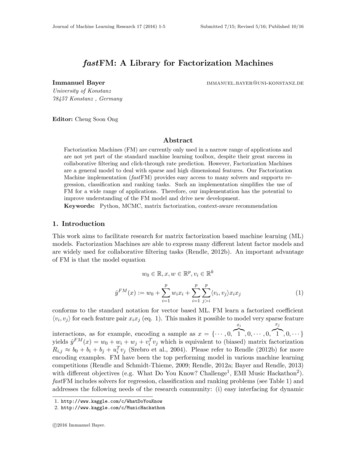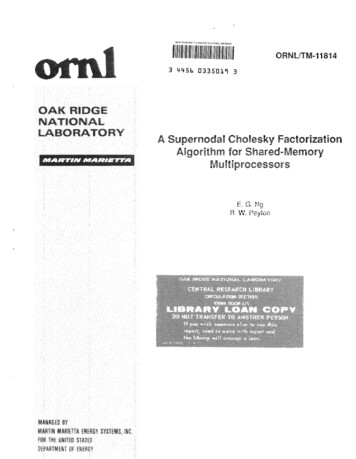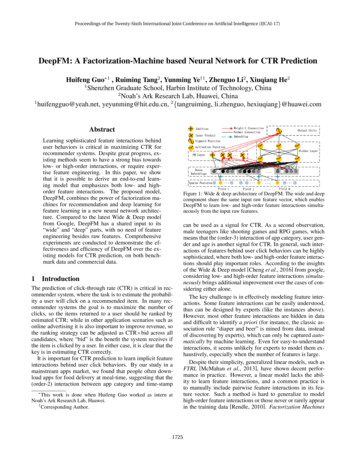
Transcription
Journal of Machine Learning Research 17 (2016) 1-5Submitted 7/15; Revised 5/16; Published 10/16fastFM: A Library for Factorization MachinesImmanuel Bayerimmanuel.bayer@uni-konstanz.deUniversity of Konstanz78457 Konstanz , GermanyEditor: Cheng Soon OngAbstractFactorization Machines (FM) are currently only used in a narrow range of applications andare not yet part of the standard machine learning toolbox, despite their great success incollaborative filtering and click-through rate prediction. However, Factorization Machinesare a general model to deal with sparse and high dimensional features. Our FactorizationMachine implementation (fastFM) provides easy access to many solvers and supports regression, classification and ranking tasks. Such an implementation simplifies the use ofFM for a wide range of applications. Therefore, our implementation has the potential toimprove understanding of the FM model and drive new development.Keywords: Python, MCMC, matrix factorization, context-aware recommendation1. IntroductionThis work aims to facilitate research for matrix factorization based machine learning (ML)models. Factorization Machines are able to express many different latent factor models andare widely used for collaborative filtering tasks (Rendle, 2012b). An important advantageof FM is that the model equationw0 R, x, w Rp , vi RkŷFM(x) : w0 pXi 1p XpXwi x i hvi , vj ixi xj(1)i 1 j iconforms to the standard notation for vector based ML. FM learn a factorized coefficienthvi , vj i for each feature pair xi xj (eq. 1). This makes it possible to model very sparse featurexixjz} {z} {interactions, as for example, encoding a sample as x {· · · , 0, 1 , 0, · · · , 0, 1 , 0, · · · }yields ŷ F M (x) w0 wi wj viT vj which is equivalent to (biased) matrix factorizationRi,j b0 bi bj uTi vj (Srebro et al., 2004). Please refer to Rendle (2012b) for moreencoding examples. FM have been the top performing model in various machine learningcompetitions (Rendle and Schmidt-Thieme, 2009; Rendle, 2012a; Bayer and Rendle, 2013)with different objectives (e.g. What Do You Know? Challenge1 , EMI Music Hackathon2 ).fastFM includes solvers for regression, classification and ranking problems (see Table 1) andaddresses the following needs of the research community: (i) easy interfacing for dynamic1. http://www.kaggle.com/c/WhatDoYouKnow2. http://www.kaggle.com/c/MusicHackathonc 2016 Immanuel Bayer.
Bayerand interactive languages such as R, Python and Matlab; (ii) a Python interface allowinginteractive work; (iii) a publicly available test suite strongly simplifying modifications oradding of new features; (iv) code is released under the BSD-license allowing the integrationin (almost) any open source project.2. Design OverviewThe fastFM library has a multi layered software architecture (Figure 1) that separates theinterface code from the performance critical parts (fastFM-core). The core contains thesolvers, is written in C and can be used stand alone. Two user interfaces are available: acommand line interface (CLI) and a Python interface. Cython (Behnel et al., 2011) is usedto create a Python extension from the C library. Both, the Python and C interface, serveas reference implementation for bindings to additional languages.2.1 fastFM-coreFM are usually applied to very sparse design matrices, often witha sparsity over 95 %, due to their ability to model interactionfastFM (Py)between very high dimensional categorical features. We use theCythonCLIstandard compressed row storage (CRS) matrix format as underfastFM-core (C)Figure 1: Library Archi- lying data structure and rely on the CXSparse3 library (Davis,tecture2006) for fast sparse matrix / vector operations. This simplifies the code and makes memory sharing between Python and Cstraight forward.fastFM contains a test suite that is run on each commit to the GitHub repository via acontinuous integration server4 . Solvers are tested using state of the art techniques, such asPosterior Quantiles (Cook et al., 2006) for the MCMC sampler and Finite Differences forthe SGD based solvers.2.2 Solver and Loss FunctionsfastFM provides a range of solvers for all supported tasks (Table 1). The MCMC solverimplements the Bayesian Factorization Machine model (Freudenthaler et al., 2011) via Gibbssampling. We use the pairwise Bayesian Personalized Ranking (BPR) loss (Rendle et al.,2009) for ranking. More details on the classification and regression solvers can be found inRendle LS, MCMC, SGDALS, MCMC, SGDSGDLossSquare LossProbit (MAP), Probit, SigmoidBPR (Rendle et al., 2009)Table 1: Supported solvers and tasks3. CXSparse is LGPL licensed.4. https://travis-ci.org/ibayer/fastFM-core2
fastFM: A Library for Factorization Machines2.3 Python InterfaceThe Python interface is compatible with the API of the widely-used scikit-learn library(Pedregosa et al., 2011) which opens the library to a large user base. The following codesnippet shows how to use MCMC sampling for an FM classifier and how to make predictionson new data.fm mcmc.FMClassification(init std 0.01, rank 8)y pred fm.fit predict(X train, y train, X test)fastFM provides additional features such as warm starting a solver from a previous solution(see MCMC example).fm als.FMRegression(init std 0.01, rank 8, l2 reg 2)fm.fit(X train, y train)3. ExperimentslibFM5 is the reference implementation for FM and the only one that provides ALS andMCMC solver. Our experiments show, that the ALS and MCMC solver in fastFM comparefavorable to libFM with respect to runtime (Figure 2) and are indistinguishable in terms ofaccuracy. The experiments have been conducted on the MovieLens 10M data set using theoriginal split with a fixed number of 200 iterations for all experiments. The x-axis indicatesthe number of latent factors (rank), and the y-axis the runtime in seconds. The plots showthat the runtime scales linearly with the rank for both implementations. The code snippetALSMCMC1500 1500 runtime [s] 1200 1000 900 600 libfm 3004 2fastFM 500 68101224681012rankFigure 2: A runtime comparison between fastFM and libFM is shown. The evaluation is done onthe MovieLens 10M data set.below shows how simple it is to write Python code that allows model inspection afterevery iteration. The induced Python function call overhead occurs only once per iterationand is therefore neglectable. This feature can be used for Bayesian Model Checking asdemonstrated in Figure 3. The figure shows MCMC summary statistics for the first orderhyper parameter σw . Please note that the MCMC solver uses Gaussian priors for the modelparameter (Freudenthaler et al., 2011).5. http://libfm.org3
Bayerfm mcmc.FMRegression(n iter 0)# initialize coefficientsfm.fit predict(X train, y train, X test)for i in range(number of iterations):y pred fm.fit predict(X train, y train, X test, n more iter 1)# save, or modify (hyper) parameterprint(fm.w , fm.V , fm.hyper param )Many other analyses and experiments can be realized with a few lines of Python codewithout the need to read or recompile the performance critical C code.Trace of σwDensity of 0IterationsFigure 3: MCMC chain analysis and convergence diagnostics example for the hyperparameter σwevaluated on the MovieLens 10M data set.4. Related WorkFactorization Machines are available in the large scale machine learning libraries GraphLab(Low et al., 2014) and Bidmach (Canny and Zhao, 2013). The toolkit Svdfeatures by Chenet al. (2012) provides a general MF model that is similar to a FM. The implementations inGraphLab, Bidmach and Svdfeatures only support SGD solvers and don’t provide a rankingloss. It’s not our objective to replace these distributed machine learning frameworks: but tobe provide a FM implementation that is easy to use and easy to extend without sacrificingperformance.AcknowledgmentsThis work was supported by the DFG under grant Re 3311/2-1.ReferencesImmanuel Bayer and Steffen Rendle. Factor models for recommending given names. InECML/PKDD 2013 Discovery Challenge Workshop, part of the European Conference4
fastFM: A Library for Factorization Machineson Machine Learning and Principles and Practice of Knowledge Discovery in Databases,pages 81–89, 2013.Stefan Behnel, Robert Bradshaw, Craig Citro, Lisandro Dalcin, Dag Sverre Seljebotn, andKurt Smith. Cython: The best of both worlds. Computing in Science & Engineering, 13(2):31–39, 2011.John Canny and Huasha Zhao. Bidmach: Large-scale learning with zero memory allocation.In BigLearn Workshop, NIPS, 2013.Tianqi Chen, Weinan Zhang, Qiuxia Lu, Kailong Chen, Zhao Zheng, and Yong Yu. Svdfeature: a toolkit for feature-based collaborative filtering. The Journal of Machine LearningResearch, 13(1):3619–3622, 2012.Samantha R Cook, Andrew Gelman, and Donald B Rubin. Validation of software forbayesian models using posterior quantiles. Journal of Computational and GraphicalStatistics, 15(3), 2006.Timothy A Davis. Direct methods for sparse linear systems, volume 2. Siam, 2006.Christoph Freudenthaler, Lars Schmidt-thieme, and Steffen Rendle. Bayesian factorizationmachines. In Proceedings of the NIPS Workshop on Sparse Representation and Low-rankApproximation, 2011.Yucheng Low, Joseph E Gonzalez, Aapo Kyrola, Danny Bickson, Carlos E Guestrin, andJoseph Hellerstein. Graphlab: A new framework for parallel machine learning. arXivpreprint arXiv:1408.2041, 2014.F. Pedregosa, G. Varoquaux, A. Gramfort, V. Michel, B. Thirion, O. Grisel, M. Blondel, P. Prettenhofer, R. Weiss, V. Dubourg, J. Vanderplas, A. Passos, D. Cournapeau,M. Brucher, M. Perrot, and E. Duchesnay. Scikit-learn: Machine learning in Python.Journal of Machine Learning Research, 12:2825–2830, 2011.Steffen Rendle. Social network and click-through prediction with factorization machines.In KDD-Cup Workshop, 2012a.Steffen Rendle. Factorization machines with libFM. ACM Trans. Intell. Syst. Technol., 3(3):57:1–57:22, May 2012b. ISSN 2157-6904.Steffen Rendle and Lars Schmidt-Thieme. Factor models for tag recommendation in bibsonomy. In ECML/PKDD 2008 Discovery Challenge Workshop, part of the EuropeanConference on Machine Learning and Principles and Practice of Knowledge Discovery inDatabases, pages 235–243, 2009.Steffen Rendle, Christoph Freudenthaler, Zeno Gantner, and Lars Schmidt-Thieme. Bpr:Bayesian personalized ranking from implicit feedback. In UAI ’09, pages 452–461, Arlington, Virginia, United States, 2009.Nathan Srebro, Jason Rennie, and Tommi S Jaakkola. Maximum-margin matrix factorization. In Advances in neural information processing systems, pages 1329–1336, 2004.5
are not yet part of the standard machine learning toolbox, despite their great success in collaborative ltering and click-through rate prediction. However, Factorization Machines are a general model to deal with sparse and high dimensional features. Our Factorization Machine implementation (fastFM) provides easy access to many solvers and .










